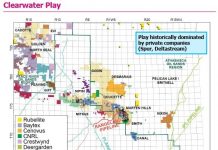Two public companies drilling in the Montney Formation of North East British Columbia and across the border into Alberta have just announced very large discoveries – more than 20 times the average production from wells in Western Canada. Both discoveries used horizontal drilling (HD).
Breaker Energy (WAV-TSX) and Fairborne Energy (FEL-TSX) each reported wells producing IP rates of 10 million cubic feet of gas per day, or mmcf/d. IP rate stands for initial production – how much oil or gas comes out of the well when it first starts producing. Oil and gas wells go down in production every year – in Canada about 20% (this is called the decline rate). These HD wells have much greater production than straight vertical wells, but decline usually about 50 or 60% in the first year, then have regular 20% declines.
The average gas well in western Canada in 2008 had an IP rate of about 425 thousand cubic feet of gas per day, or mcf/d. 10,000,000 is a BIG well – in oil terms (at 6:1) that’s a 1,667 barrel of oil per day well. Very big. It speaks to the potential of these new gas plays across North America that are being opened up with HD and its sister technology, multi-stage fracing. These formations have been known about for decades, but only became economic in the last few years with these new technologies.
Another company, Storm Exploration (SEO-TSX) announced a reserve increase of 109% in 2008 because of their success in discovering gas in the Montney play. The stock had a nice pop on the news, but I need to call the company because the prices they were using to qualify those reserves – though they were independent – were CAD$7.24 per mcf in 2009 and CAD$70 for oil. I would suggest both of those prices are very high; almost beyond reason. Gas futures don’t get above US$6 (roughly CAD$7.50 equivalent) until December this year.
INVESTOR OPPORTUNITY – RESERVE DOWNGRADES
Each year as a company gets audited it must report what its reserves are at the prevailing oil and gas prices. (The industry calls it a “ceiling test”.) Reserves are the proven amounts of oil and gas in the ground the company has discovered but has yet to produce. As these commodity prices go down, so do the reserves; a pool of oil might be so deep or so small that under say, $50/barrel, it becomes uneconomic. These reserves are the primary asset of the company. A company’s bankers decide how much to lend based on cash flow and reserves – at a certain oil and gas price.
There is a strong likelihood that MANY TSX-listed energy companies will see SIGNIFICANT writedowns in reserves. The question is – has that already been priced into the stock. Certainly if the prices used in Storm’s reserve calculation are used, there won’t be significant downgrades.
There will be a trading opportunity if stocks get hit hard as these companies announce reserve reductions. The selling will get overdone and the good companies will bounce back. There are many good companies with strong management teams who are prudent, competent operators.
An example of bad news hitting a stock is Canadian Oil Sands trust, symbol COS.UN on TSX. They cut their monthly payout to shareholders by 80%, and the stock was way down on the open this morning to $16.69 , but has since bounced back to over $18 and many analysts still have a $25 target for the stock.
Our newsletter will cover some trading opportunities, but is more concerned with picking the best of the litter and following them as they grow.








